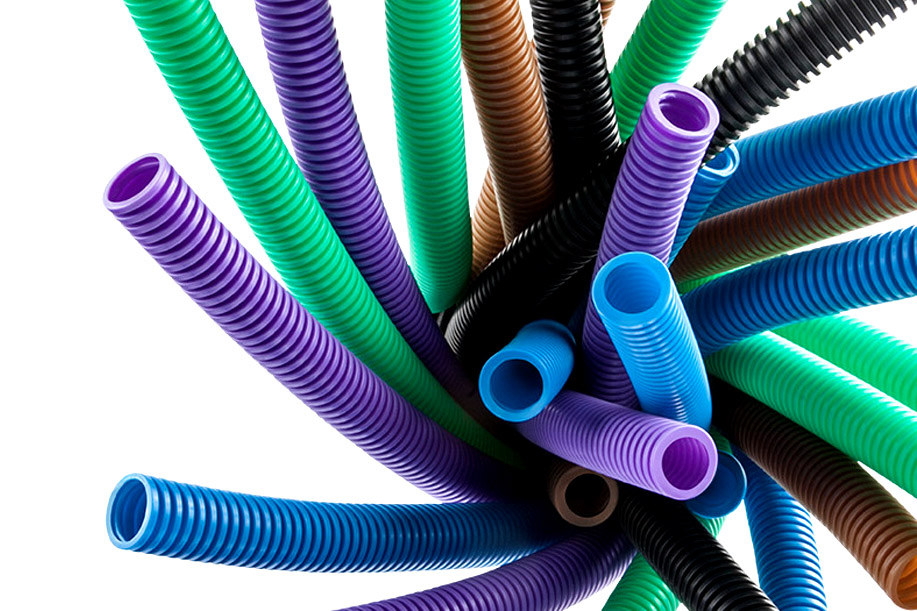In the construction of a civil electrical system, one of the first phases concerns the laying of protective pipes within which the electrical cables must be routed in an orderly and safe manner.
The installer is therefore required to choose the most suitable piping not only for the electrical system but also for the accessory systems such as the TV antenna, the telephone socket, and the data and intrusion detection systems.
Using corrugated conduits implies that the installation is well tracked, that is to say inside the walls and under the floor. However, it is not always possible to incorporate the system into the walls, especially when renovating prestigious buildings.
In these cases, cable ducts are used to create a safe and tidy installation, achieving excellent results also from an aesthetic point of view.
Corrugated protective conduit
When choosing the diameter of a corrugated conduit, it is necessary to take into account the CEI 64-8 Norm. According to this norm all the cables must be removable, and the internal diameter of the corrugated conduit must be at least 1.5 times the average diameter of the bundle of cables it contains. The result must be increased by 10% if the route is more than 10 meters or if there are some bends. However, the minimum diameter must not be less than sixteen millimetres.
Corrugated cables have the advantage of being flexible, adapting to the imperfections of the track made on the wall and although bends of less than 90° can be obtained, it is always good to make the widest possible bends to reduce the difficulties when inserting cables.
Depending on the cables they contain, the corrugated conduits have their colour.
Although not mandatory, the choice of colour for the undertrack conduits is dictated by the logic of grouping together similar cables and making them easily identifiable in the event of repairs or maintenance involving the demolition of parts of the building where they are contained, such as for example, the renovation of the floor and the subfloor.
Thus the black and grey corrugated conduits are intended to contain cables of the electrical system, the blue corrugated conduits will contain the cables of the intercom system, the purple is intended to contain cables of the audio/video system, in the white corrugated conduits will pass the data and TV cables, the green the telephone, data and TV cables, in the brown corrugated conduits there will be the alarm system cables.
The final result of installing a system keeping track of the corrugated protective conduit is that you will have rooms where you can’t see its presence, and the only elements of the electrical system that will be visible are going to be the switches and the junction box covers.
Visible cable channels
It is not always possible to make tracks on the walls in which to insert the corrugated conduits. In these cases, the cable channels allow the electrical installation to be carried out while maintaining all safety requirements. Channels are also used in the renovation of historic buildings or buildings subject to restrictions.
They are also used in cases where there is already an undertrack system, but new lighting points or sockets are required without opening new tracks on the walls, as in the case of a new television set that is moved from the previous position.
The installation of cable channels is rather simple, they are fixed to the existing masonry with dowels avoiding the construction and subsequent filling of the tracks on the walls.
They are cut to the size of the sections to be executed, and the bends are obtained with internal and external angle elements with variable openings to follow the geometry of the walls.
The system is installed more quickly and by placing the cable channels on the wall flush with the floor, they can easily be mistaken for skirting board, thus reducing the aesthetic impact.
Safety is ensured by the airtight sealing of the lid, which must be waterproof for outdoor installations such as terraces or balconies.
Comparing two systems, one made with corrugated conduits and one with channels, there are substantial differences:
- the system using corrugated conduits needs to be tracked on the wall, so in addition to the construction costs of the system you need to add the costs of the construction work for opening and closing the tracks, while the installation of cable channels is much easier and is carried out more quickly;
- from an aesthetic point of view, though, the system built under the track with the corrugated conduit, hidden inside the walls, gives more order to the room, unlike the cable channels that will always be noticed.
In conclusion, the choice between corrugated conduit and channels is essentially based on two requirements: economic and aesthetic.
From an economic point of view, cable channels are preferable. However, if the aesthetic requirement prevails, the system made under the track with corrugated conduits is unrivalled.

